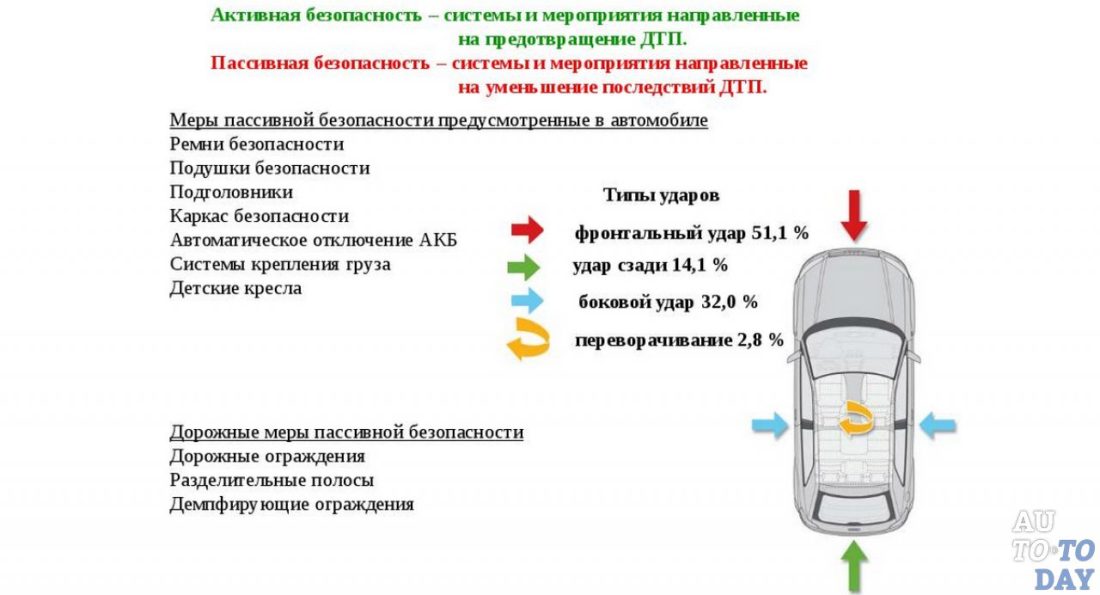
Passive safety as a relative concept
 With a new car or generation entering the market, it becomes more and more obvious that the crash tests passed, as usual, will be fully appreciated. Every automaker loves to brag that their new product meets ever more stringent safety standards year after year, and highlights even more if they add a safety feature that was not previously available in the lineup (such as an urban collision avoidance system). speed by radar signal).
With a new car or generation entering the market, it becomes more and more obvious that the crash tests passed, as usual, will be fully appreciated. Every automaker loves to brag that their new product meets ever more stringent safety standards year after year, and highlights even more if they add a safety feature that was not previously available in the lineup (such as an urban collision avoidance system). speed by radar signal).
But everything will be fine. What are crash tests and what are they for? These are tests designed by experts primarily to reliably simulate certain types of real-world shocks that happen by chance or unintentional on a daily basis. They consist of three main parts:
- Assistance with resumes writing for testing (i.e. preparation of cars, dummies, cameras, measuring instruments, subsequent calculations, measurements and preparation of other accessories),
- very crash test,
- analysis measured and recorded information and their subsequent evaluation.
Euro NCAP
In order to cover all prescribed hits, the test does not consist of a single demolition, but, as a rule, commissioners "break" several cars. In Europe, the most popular crash tests are carried out by the Euro NCAP consortium. In the new methodology, testing is divided into 4 main parts. The first concerns the protection of adult passengers and consists of:
- Frontal strike at a speed of 64 km / h to a deformable barrier with 40% coverage of the car and obstacle (i.e. 60% of the front surface of the car does not make initial contact with the barrier), where the safety of adults in the head, neck, chest area is strictly controlled (cab and load when decelerating with a seatbelt), thighs with knees (contact with the lower part of the dashboard), shaving and, for the driver and legs, (danger of moving the pedal group). The safety of the seats themselves and the stability of the body roll cage are also assessed. Manufacturers may document similar protection for passengers of other heights than mannequins or mannequins. in a different seat position. A maximum of 16 points will be awarded for this part.
- Bhitting the eye with a deformable barrier at a speed of 50 km / h to a stationary car, where the safety of the adult is again monitored, in particular his pelvis, chest and head in contact with the side of the car, or the effectiveness of the side and head airbags. Here the car can get a maximum of 8 points.
- Side collision of a car with a fixed column at a speed of 29 km / h is not mandatory, but car manufacturers are already completing it regularly, the only condition is the presence of head airbags. The same parts of the body of an adult are evaluated as in the previous blow. Also - a maximum of 8 points.
- Oprotection of the cervical spine in a rear impact, this is also the last test for adult passengers. The shape of the seat and the angle of the head are controlled, and it is interesting that many seats still perform poorly today. Here you can get a maximum of 4 points.
The second category of tests is devoted to the safety of passengers in the passenger compartment of children, marking for the installation and attachment of seats and other safety systems.
- Two mock dummies are observed. children 18 and 36 monthslocated in car seats in the rear seats. All collisions mentioned so far must be recorded, with the exception of a rear impact simulation. After successful completion, both dummies can receive a maximum of 12 points independently of each other.
- Below is a rating of 4 points maximum for car seat clamping point markings, and the options themselves provide 2 points for car seat clamping.
- The conclusion of the second category is the assessment of sufficient marking of the deactivated state of the passenger airbag on the instrument panel, marking the possibility of deactivating the passenger airbag and the subsequent possibility of placing the car seat in the opposite direction, the presence of three-point seat belts and warnings. Just 13 points.
The third category controls the protection of the most vulnerable road users - pedestrians. Comprises:
- Nat the price of impact simulation baby head (2,5 kg) a adult head (4,8 kg) on the hood of the car, skillfully for 24 points (note: a normal result of 16-18 points, which means that even cars with a full overall rating usually do not reach the maximum rating level).
- Pelvic stroke o the edges of the bonnet with a maximum score of 6 (often the most dangerous location for pedestrian injury, with a score of about XNUMX).
- Kick o middle and lower bumper, where cars usually get a full 6 points.
The last, last, fourth category assesses auxiliary systems.
- You can also get reminders of unfastened seat belts and the presence of a modern serial stabilization system - for 3 points, the car receives a speed limiter, if installed.
The overall result, as many of us already know, expresses the number of stars, where 5 stars means better security, which gradually diminishes as the number of stars decreases. The criteria have been gradually tightened since the start of the crash test, which means that a car that receives full stars at launch will achieve safety levels, for example, at today's three-star level (see the latest three-star results for the Peugeot 107 / Citroen C1 / Toyota triple Aygo , with the highest rating at the time of market entry).
Criteria for evaluation
After all, what criteria do modern cars have to meet in order to be proud of the best "star" rating? The final result is awarded based on the point score of each of the four mentioned groups, expressed as a percentage.
The latest NCAP is designed to 5 star rating with a minimum profit:
- 80% of the total average,
- 80% protection for adult passengers,
- 75% child protection,
- 60% pedestrian protection,
- 60% for auxiliary systems.
4 star rating the car deserves compliance for:
- 70% of the total average,
- 70% protection for adult passengers,
- 60% child protection,
- 50% pedestrian protection,
- 40% for auxiliary systems.
3 stars victory rated:
- 60% of the total average,
- 40% protection for adult passengers,
- 30% child protection,
- 25% pedestrian protection,
- 25% for auxiliary systems.
Finally, in my opinion, I came to the most important point of this article, which was also the first stimulus for this topic. The name itself describes it very accurately. A person who decides to buy a new car also because of the use of the latest safety procedures and systems, and therefore the highest possible safety, must understand that he is still buying only a sheet metal and plastic “box” that can actually move. dangerous speeds. In addition, the full transmission of forces to the road is ensured by only four contact surfaces of tires of standard size "dad". That even the latest top-rated model has its limits and was designed with pre-known impacts that engineers took into account during development, but what happens if we change the impact rules? This is exactly what the American Highway Traffic Safety Organization called INSURANCE INSTITUTE FOR ROAD SAFETY already in 2008 under the name Small overlap test... By the way, it is known for harsher conditions than in Europe, including the rollover test of SUVs (expressed as a percentage of the potential rollover), which are so successful behind the big bump.
Small overlap test
Or otherwise: a head-on impact on a solid obstacle with a small overlap. This is a head-on collision at a speed of 64 km / h into a non-deformable (stationary) obstacle with an overlap of only 20% (the car meets and first of all hits an obstacle only on 20% of the forward view area, the remaining 80% do not touch the obstacle during the initial impact). This test simulates the impact after the first attempt to avoid a hard obstacle such as a tree. The rating scale consists of four verbal ratings: good, fair, borderline, and weak. Surely you are talking because it is similar to our country in Europe (40% overlap and deformable barrier). However, the results stopped everyone, since at that time even the safest cars were not designed for this impact and gave the driver fatal injuries even at the "city" speed. Time has advanced, as have some manufacturers in this regard. It is clear to see the difference between a model that is ready for this type of impact, and a model with which the developers have not delivered so many robots. Volvo is right in this area of safety and has modeled its new (2012) S60 and XC60 models, so it should come as no surprise that the cars received the best possible ratings. She also surprised the mini Toyota iQ, which also performed very well. Most of all, I was personally surprised by the latest model BMW 3 F30, which the commissioners rated as marginal. In addition, two Lexus models (as the more luxurious offshoot of the Toyota brand) did not achieve very satisfactory ratings. There are several proven models, all of them are freely available on the network.
